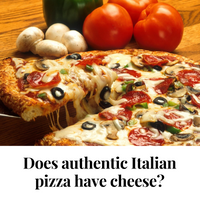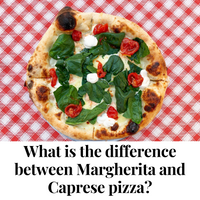
In Italy, everyone has their own opinion while discussing pizza. There are those who favor soft or crispy pizza, thin or thick, red or white, and those who prefer it higher. To each his own, and it is hard to determine which version is best. It is really challenging to create a categorization when you consider that there are so many varieties in the world. To begin, let's be clear that there are numerous varieties of pizza available in Italy. We have all agreed that Roman pizza, pizza Napoli style pizza, and Neapolitan pizza should be distinguished from one another.
It is nearly hard to determine which variety of pizza the Romans or the Neapolitans created first. Due to the numerous influences, this Italian cuisine has had over the years, its history is lengthy and unclear. White flatbread pizzas have been around since ancient times, whether they were leavened or not, and were popular among the Romans and Egyptians. However, we cannot tell for certain if these were the original pizzas or not. We may be certain that one of the earliest records in which the word "pizza" occurred was in the year 997 in the province of Gaeta in Latina. Naples pizza menu is the right option to opt for.
Characteristics of Roman pizza
Due to the crumbly nature of its dough, the Roman pizza is often referred to as the "scrocchiarella Roman pizza". This pizza is the most well-known in Italy, despite the fact that it is difficult to identify because it lost its "crunchy" quality over time and as a result of national distribution. Fortunately, efforts are being made to restore the Roman pizza's original qualities. You can choose the best pizza variant from the Naples pizza menu.
Here they are:
- The dough is crispy and thin;
- It has a thin, crumbly crust.
- Olive oil, soft wheat flour, water, yeast, and salt are all used to make the dough.
- Using a rolling pin, it is formed and made flat;
- The extra cooking time enables the oven to dry the dough and create crusty bread.
Characteristics of Neapolitan pizza
Together with pasta, this kind of pizza serves as a true representative of Italian and Neapolitan cuisine.
Here are the characteristics:
- The dough is soft, and the "cornicione" crust, which rises high and softly absorbs air as it is kneaded;
- Water, flour, yeast, and salt are used to make the dough; no oil or lard is used in its preparation.
- In the hardwood oven, cooking lasts between 50 to 90 seconds.
Like Roman pizza, Neapolitan pizza contains a variety of seasonings, but the Marinara and Margherita varieties are the most common. The first one has oil, tomato sauce, garlic, and oregano, while the second one, possibly the most well-known in the world, contains oil, tomato sauce, mozzarella cheese, and basil.

What, therefore, distinguishes a Roman pizza from a Neapolitan pizza?
We've discussed the traits of these two well-known varieties of pizza, but what are the actual distinctions between Roman and Neapolitan varieties? The first is thin and crunchy, while the second is fluffy and soft. The Neapolitan one does not use oil, while the Roman one does. The Neapolitan pizza takes 50–90 seconds in the wooden oven, whereas the Roman pizza needs a slow cooking time. The manner in which it is served is the last difference. Even though both are ideal for eating on the go, the Neapolitan pizza is folded in four with a special food paper and is known as a calzone, while the Roman pizza is served by the slice.
Pizza Alla Pala
Pizza alla pala, which translates to "paddle pizza" in Italian, was created in Roman bakeries as a method to use up extra bread dough. The dough was stretched lengthwise by the bakers, topped with fresh ingredients, and served on a wooden paddle by the slice. Unlike pizza Napoletana, this variety is cooked in an electric oven at a temperature of roughly 580°F and contains a highly hydrated dough (about 80% water). Each slice of bread has a soft, fluffy center and a crispy exterior thanks to the dough's thicker texture and prolonged rising period.
Pizza Fritta
Pizza fritta is fried pizza dough and is a traditional Neapolitan street snack. It can take on a variety of shapes and sizes. For instance, calzone has a half-moon form while montanara is spherical. Pizza fritta was created as a result of a crisis, like many other wonderful things in life. After World War II, the cost of wood for ovens and mozzarella significantly soared. Cooks in Naples chose to fry the dough rather than bake it and fill it with items they had on hand in order to continue serving their traditional dish. Panzerotti is yet another variation of fried pizza. Pizza dough is loaded with cheese, tomatoes, and ricotta to form panzerotti, which is then deep-fried till golden.
Pizza al Padellino
Pizza al padellino, sometimes known as "pan pizza," is a variety of pizzas baked in tiny, oblong pans. Consider it similar to an Italian "deep dish." Pizza al padellino, which is frequently served in Torino, features a thick, soft crust that bakes to a light brown on the outside. Prosciutto, mozzarella, and other toppings can be used to top it.
Sicilian pizza
Sicilian-style pizza, also referred to as sfincione, features a thick crust with a fluffy, sponge-like texture. It is baked in a rectangular pan and covered with hard sheep's milk cheese, tomato sauce, anchovies, onions, and oregano. Breadcrumbs are applied to the pizza as a finishing touch, helping them to absorb some of the oil from the toppings.
Conclusion
Pizza Napoli styles are available in many different variants. With so many variants of pizza, this dish has undoubtedly become people’s favorite over time. We at Pizza Bien, focus on bringing in the best, authentic, flavorful pizza for all of you. With ingredients coming down all the way from Naples, get ready to enjoy this Italian delicacy. Click here to order now!!!









0 comments